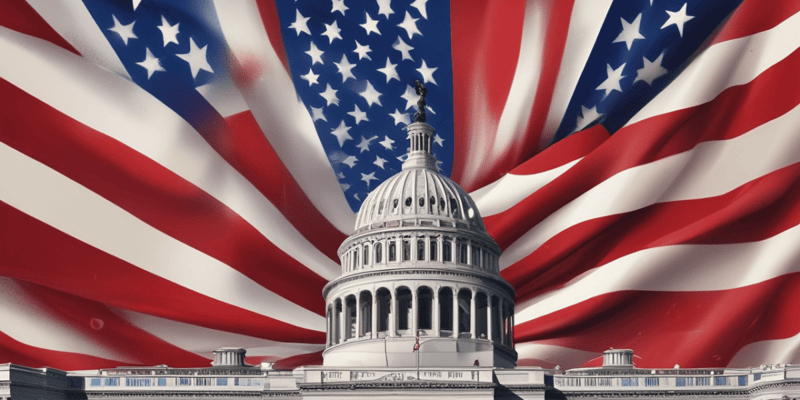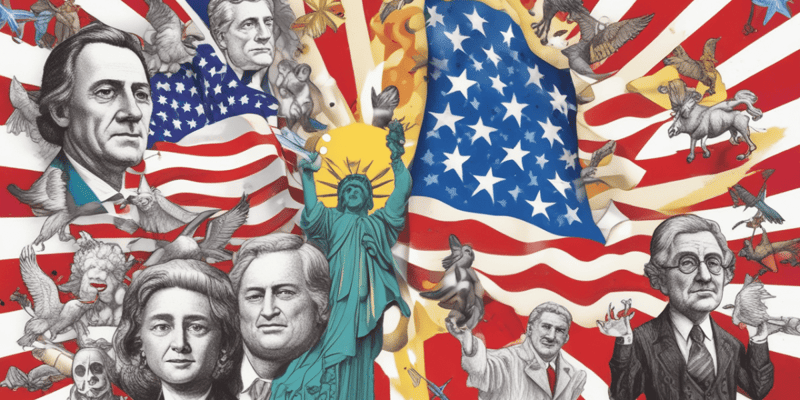Questions and Answers
What is the main difference between the Democratic and Republican parties?
The Democratic Party is left-of-center, while the Republican Party is right-of-center
When did the fourth party system begin?
1896
What is the main ideology of the Libertarian Party?
Minimally regulated markets and a less powerful federal government
What is the main focus of the Constitution Party?
Signup and view all the answers
Which of the following statements is true about third parties in the United States?
Signup and view all the answers
What is the Alliance Party?
Signup and view all the answers
How many independents currently serve in the U.S. Congress?
Signup and view all the answers
What is the main argument of those who propose an end to the two-party system?
Signup and view all the answers
Are independents allowed to vote in primary elections in all states?
Signup and view all the answers
Study Notes
Overview of the American Two-Party System
-
The two dominant political parties in the United States are the Democratic Party and the Republican Party, which have controlled the presidency and Congress since the mid-19th century.
-
While third parties exist, they have not been successful in winning national elections and most people identify as either Democrats or Republicans.
-
The two parties have evolved in terms of ideologies, positions, and support bases over time, with the Democratic Party being left-of-center and the Republican Party being right-of-center.
-
The history of the two-party system can be divided into six eras or "party systems", starting with the Federalist Party and the Democratic-Republican Party in the late 18th century.
-
The Constitution is silent on political parties, and the Founding Fathers did not intend for American politics to be partisan.
-
The parties have changed their ideologies and bases of support considerably over time, with the Democratic Party now being strongly pro-civil rights and disproportionately composed of women, LGBT, union members, and urban, educated, younger, non-white voters, and the Republican Party being disproportionately composed of family businesses, less educated, older, rural, southern, religious, and white working-class voters.
-
The third party system emerged with the anti-slavery Republican Party in 1854, which became the dominant party after the Civil War and was associated with the successful military defense of the Union.
-
The fourth party system began in 1896 with the Progressive Era and saw a shift in central domestic issues to government regulation of railroads and large corporations, the protective tariff, labor unions, child labor, and control of immigration.
-
The fifth party system began in 1932 with the Great Depression and the New Deal programs of Democrat president Franklin D. Roosevelt, which created a dramatic political shift toward liberalism.
-
The sixth party system emerged in the 1980s and was characterized by increased political polarization, with the Republican Party becoming the base of rural and working-class whites and the Democratic Party being increasingly made up of a coalition of African Americans, Latinos, and white urban progressives.Overview of American Political Parties
-
American political parties are loosely organized and lack a central ideology.
-
The two major parties are the Democratic Party and the Republican Party.
-
The Democratic Party positions itself as the liberal party on domestic issues and has been associated with civil rights.
-
The Republican Party is more market-oriented and supports economic liberalism, fiscal conservatism, and social conservatism.
-
Minor parties include the Libertarian, Green, and Constitution parties.
-
The Libertarian Party is the largest third party and supports minimally regulated markets and a less powerful federal government.
-
The seventh party system may have begun with Donald Trump's campaign for president, which emphasized cultural conservatism, opposition to economic globalization and immigration from non-European countries, and loyalty to Trump.
-
American politics has become overly focused on national issues and nationalized.
-
Both major parties have a national committee, but they have weak central organizations and little central ideology except by consensus.
-
Political parties in America have become more like labels to mobilize voters than political organizations.
-
Third parties have appeared from time to time in American history but seldom lasted more than a decade.
-
Elections are usually portrayed as national races between the political parties, with presidential candidates becoming the de facto leader of their respective party.Overview of Political Parties in the United States
-
There are two major political parties in the United States, the Democratic Party and the Republican Party.
-
The Libertarian Party is a third party in the United States that promotes liberalization, open immigration, non-interventionism, and neutrality in diplomatic relations, free trade, and free movement to all foreign countries, and a more representative republic.
-
The Green Party is another third party that emphasizes environmentalism, non-hierarchical participatory democracy, social justice, respect for diversity, peace, and nonviolence.
-
The Constitution Party is a national conservative political party in the United States that focuses on constitutionalism and conservative values.
-
The Alliance Party is a centrist American political party that was formed in 2018 and registered in 2019, gaining affiliation status with multiple other parties.
-
Multiple individuals from various stances have proposed an end to the two-party system, arguing mostly that the Democratic and Republican parties don't accurately represent much of the national electorate.
-
NBC News' Dante Chinni and Washington Post columnist Perry Bacon, Jr. have both suggested that the United States' political system is that of four parties grouped into a two-party system.
-
Former Secretary of Labor Robert Reich, political theorist Carl Davidson, and political theorist Lee Drutman argue that the United States primarily falls into six political parties.
-
Independents are not affiliated with political parties, and some political candidates and voters choose not to identify with a particular political party.
-
As of late 2022, only two independents serve in the U.S. Congress, Senators Angus King and Bernie Sanders.
-
According to Ballotpedia, as of 2022, there were 24 seats held by independents in state legislatures and 10 seats held by third parties.
-
In some states, independents are not allowed to vote in primary elections, but in others, they can vote in any primary election of their choice.
Studying That Suits You
Use AI to generate personalized quizzes and flashcards to suit your learning preferences.
Description
Think you know everything about American political parties and the two-party system? Test your knowledge with this informative quiz! From the ideologies and support bases of the Democratic and Republican parties to the emergence of third parties and the history of the six-party systems, this quiz covers it all. You'll also learn about the minor parties in the United States, the role of independents, and the debates surrounding the two-party system. So, sharpen your political knowledge and take this quiz today!





